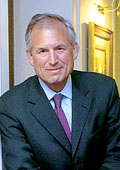 |
|
"A burgeoning order book is both
a huge opportunity and a huge risk"
|
A little
less than two years ago, when Boeing tapped Walter James
'Jim' McNerney Jr. to be its CEO, it was in desperate need
of a course correction. Late in 2003, Boeing's CEO of seven years,
Philip M. Condit, had to resign over a defence scandal, and his
replacement, Harry C. Stonecipher, was also forced to quit within
15 months after his affair with an employee came to light. With
its reputation in tatters, the Chicago-based aircraft (and defence
equipment) manufacturer turned to McNerney. The result was salutary.
On the day (June 30) McNerney's appointment was announced, the
Boeing stock rose 7 per cent and has been climbing since. It is
up more than 50 per cent over the last two years on the back of
a strong turnaround. Boeing's revenues are clipping at 15 per
cent per annum, aircraft deliveries are up almost a third at 398
planes in 2006, and costs have been reined in. In India, Boeing
has been bagging some big orders against stiff competition from
European rival Airbus. In 2005, Air India, Jet Airways and SpiceJet
ordered almost 100 airplanes from Boeing, and in 2006, Jet ordered
another 10 airplanes (all of them 787 Dreamliners, Boeing's first
commercial jet this decade), and so did SpiceJet and Air Sahara.
But all eyes are on Boeing's bid for 126 multi-role aircraft that
Indian Air Force wants to buy. It has fielded its fighter jet,
the F-18 Super Hornet, as a candidate. In India recently, McNerney,
57, took time off to give his only media interview to BT's
R. Sridharan and Kushan Mitra. Excerpts:
How would you rate your first two years
at Boeing against your own expectations?
I am fairly pleased with the progress of the
last two years. We had just left a period of instability, so part
of my job was to restabilise the management and the company, and
focus on some pretty successful programmes that were already ongoing,
and we had to take some risk out of the company and we did that.
But, by and large, I focussed on values, on management and leadership
and finding ways for all of us to believe in ourselves. I spent
a lot of time with people in the company. (As an independent director
on the Boeing board since 2001) I had working knowledge of the
company, so the issues and opportunities were not mysteries to
me. So I was able to hit the ground running in that sense.
Your last two jobs were at 3M, a company
known for its culture of innovation, and at GE, famous for its
management systems. How much learning from these two places are
you trying to implement at Boeing?
Well, I am the sum of my experiences, so I
am not sure if I consciously bring any elements of my experiences
to this job. But there is no doubt that the GE management and
leadership style has a certain edge to it, focussing on productivity
as well as growth. 3m is more innovative and topline oriented.
Boeing is more aspirational and mission oriented, excited about
things that are bigger than themselves. It is a company that does
big things and wants to do big things.
The last two years have also been very
successful for Boeing. How much has a burgeoning order book helped
the company?
The 'burgeoning order book' that you mention,
and we have a backlog of over a quarter of a trillion (dollars)
right now, is both a huge opportunity and a huge burden. Because
we have a lot of execution in front of us and much of it remains
to be developed. But it is also an opportunity (because) as we
implement the backlog over the next five-seven years, we will
get into a very favourable position in the aerospace industry.
 |
|
"We are not taking advantage of India's
engineering abilities"
|
With the Dreamliner, Boeing is revolutionising
aircraft manufacturing, bringing in components from all over the
world. What benefits do you see accruing to the company as a result
of the learnings from the 787?
Well, first of all, this is all very exciting
but also very challenging. We are leveraging the capabilities
of globally competitive companies as opposed to depending on ourselves
to get everything done. It is a form of risk mitigation, in the
sense that the bottleneck is not just the thinking and capabilities
at Seattle. We are leveraging equally strong capabilities in Japan,
Italy, Germany, France and the UK. Now, there is certainly a challenging
aspect to this, because we have to work together on a real-time
basis, every minute of every day, using the same design tools
on a global basis. All this is enabled because of a fantastic
global information technology (IT) environment. We are designing
parts, accomplishing engineering tasks all with real-time visibility,
so time and distance really mean less.
But something must have happened in the
back end as well. Last year you delivered a third more planes
than in 2005, and this year you plan to deliver over 440 aircraft.
So what were the major changes that you have put in place in assembly?
When you are putting together four million
parts and if one part doesn't show up, you can't fly the airplane.
So it is a tremendous logistical task and as we rely more and
more on our supplier partners to aggregate parts into sub-assemblies
and major components. We can do this whole process more efficiently
because it is not one supply-chain leveraging relationships, it
is multiple supply-chains that are all linked together in an it
world. But it is also about having more procurement managers supervising
things and having more quality inspectors making sure that things
go right.
For a two-horse industry, commercial aircraft
is a tough business. Manufacturers find it hard to make money,
and so do the airlines that buy these aircraft. Why?
I won't get too defensive about our financial
performance, but it is improving. The commercial airline space
is highly competitive and does go through periods of difficulty.
But I believe that we can be competitive and that our financial
performance can improve significantly.
What would you make of the problems at
your main competitor EADS (owners of Airbus), especially in the
light of what Boeing went through a decade ago?
Well, this is a tough business and they are
going through a difficult development challenge with the A380.
I understand how difficult it is and we all face these problems
sometimes in our career and, to be honest, actually I feel somewhat
sympathetic. But they will straighten these problems out and they
will be a formidable competitor as they have been for the last
thirty years.
The 787 promises to be a lot more efficient than the planes
before it. Do you think that will help airlines make more money?
Make no mistake. This is a revolutionary new
airplane. In an industry where 3-4 per cent is considered a breakthrough,
we are giving 20 per cent improvements over aircraft such as the
767 and A330 on a variety of factors. Fuel-burn, environmental
impact and others, and with more point-to-point travel, we believe
that the average size of airplanes over the next few years will
actually go down, not go up! This has been a difficult project,
we are ahead on some things, behind on others. But we believe
that entry into service will happen when we say it will, in early
2008.
 |
|
"We are not against technology transfer
as a form of partnership"
|
That said, you did just announce a new
and much bigger version of the 747, the 747-8.
I'm not saying that there won't be a market
for large airplanes, but I believe far more small and medium sized
aircraft will be sold, bring the average down. More point-to-point
travel, more frequencies, consumers don't want to go through hubs.
You have done a great deal of the avionics
software development for the 787 out of India. In the future do
you see more work happening out of India-maybe engineering work
like EADS is doing and perhaps manufacturing in the future?
I think we will be doing a lot more here over
the next five years. It is hard for me to know the exact timeframe
though. We are moving management to India, and we are connecting
that management with our decision-makers back in the US who are
designing and building these airplanes. We will see a lot more
from India. We are not taking advantage of India, either in its
aerospace ability or in its fundamental engineering and software
abilities. So we see a huge opportunity out of India.
Do you ever see India as a manufacturer
in aerospace?
Yes, I do. I see some significant component
work done both in the commercial aircraft segment and in defence,
particularly as the latter is now open to us. Assuming some success
there which we are anticipating, we believe significant amount
of component work will get done out of India.
So you expect success in the large 126-aircraft
order for multi-role aircraft the Indian Air Force is placing?
We always expect success and sometimes we
actually have it! But the spaces I think we are really competitive
are the border patrol multi-maritime aircraft and the multi-role
fighter, where the Super Hornet does a great job of meeting expectations.
There are some weapons systems and depending on market opportunities
we will see what happens.
In the multi-role aircraft order there
is expected to be some terms for technology transfer and manufacture
of the last hundred-odd aircraft in India. You have no problems
with that?
Well, I don't know the details of the proposal
as yet, but I will say that within the limits of the government
of the country I am in (the us has some limits on technology transfer),
we have nothing against technology transfer as a form of partnership.
It strengthens our global capabilities. We always have to be mindful
of constraints, but we are anxious to partner here, we really
are, because I think India has so much to offer.
The Chinese government recently announced
that they plan to make a large aircraft, and they recently started
work on a small jet plane called the ARJ-21. Do you think the
Chinese can pull off these plans?
I think they will be in this business some
time. I'm not sure when, it could be 20 years from now, but they
have the engineering and manufacturing skills and they have a
big internal market and they also have a government that is making
this a big, important priority, which helps. The big hurdle they
will have to overcome is convincing customers of their long-term
support and reliability, and that is tough. That is what the 'Boeing'
brand gives customers. So they will have to be in the business
for a while before they will get there, it will take some time.
But they have all the ingredients to eventually succeed.
Boeing has predicted that India has a
market worth $72 billion over the next two decades, but the health
of some of the low-cost carriers is suspect, to say the least.
How do you see that impacting Boeing?
I am still very optimistic about the Indian
aviation sector. There has been a great entrepreneurial spirit
here, but even in growth markets such as this there might be a
need for some common-sense consolidation. I can't exactly predict
what the industry structure in India will be like, but we will
be here to support it, no matter what the structure.
|







